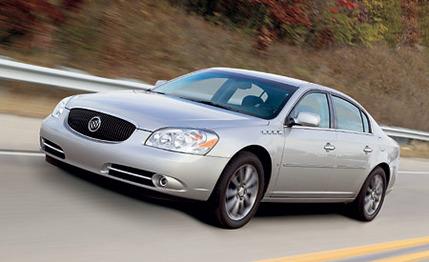 Road Test
Road Test
Aging Buick aficionados - are there any other kind? - will instantly decode the chrome sawtooth gewgaws on the front fenders of this new Lucerne-they're the latest incarnation of the famous portholes, VentiPorts in original Buickese. Youthful Buick aficionados - only unconfirmed sightings have been reported - will ask, "Oh?"
That's because they missed the glory days when Buick sales squeezed into third place nationally in 1955 and '56, just behind Ford's. The portholes were the punch marks in your status ticket then. Low-priced Special and Century models got three holes, the full-boat Super and Roadmaster got four. If a neighbor filled his driveway with a new four-holer, then he was the Jones everyone had to keep up with.
Given their fame, the reign of the portholes was quite short (probably shorter than this historical digression - Ed.), 1949 through 1957. Buicks for 1958 had so many other chrome furbelows that there was no room for holes. They came back as halfhearted vestiges on a few models in the '60s and '70s, but no one was counting by that time. Apparently, even Buick lost the formula, because when the flagship Park Avenue Ultra was launched in 2003, it was a three-holer. Some Ultra.
Arguably, this Lucerne is a real four-holer (five 'graphs just for this?-Ed.), built on the same front-drive platform as the new Cadillac DTS in the same plant in Hamtramck, Michigan. The top-of-the-line CXS tested here even uses the same 4.6-liter Northstar V-8. This is the first V-8 Buick car in a decade, GM says.
The Lucerne is big iron by today's standards, 6.4 inches longer than the hulking Chrysler 300, 2.5 longer than a Ford Five Hundred, but 4.4 shorter than its Cadillac DTS sibling. Apart from the reinterpreted portholes, the wedgy shape seems familiar and tired, a repeat of a '90s Camry; only the big-eye look in front saves it from being a complete cliché. Inside is a different story, fresh and appealingly minimalist. The shapes are smooth and soft. The details are happily integrated, like a deftly done symphony. No pretentious gestures grab for your glance. The three round dials in the cluster have understated markings. Big knobs with radiused chrome edges work the stereo, HVAC, and lights. The steering-wheel controls for cruise and entertainment are unobtrusive yet, at the same time, large and exceptionally easy to use. The six-CD changer has an input jack for auxiliary devices - podcasts, anyone?
You're surrounded by a first-rate simulation of quality materials. In fact, the Lucerne interior is a panorama of plastic under soft-touch paints, trimmed in obviously fake wood, but someone worked hard on the details. The shines and sheens look classy, and the stitched seams across the doors, seats, and console are convincingly craftsmanlike. The windshield pillars are smoothly covered in headliner material, eliminating molding lines and distracting glare. The large sun visors slide on their arms, allowing exceptionally good coverage to the sides. If you don't look too critically at the details of console bins and hatches, the appointments live up to four-holer expectations.